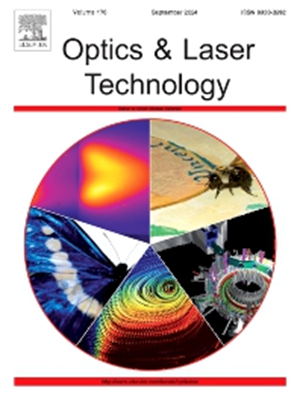Precision processing of Nb-Si alloy via water-jet guided laser: Realization of inhibited-oxidation and small-taper
IF 4.6
2区 物理与天体物理
Q1 OPTICS
引用次数: 0
Abstract
Nb-Si alloy holds great promise as a crucial high-temperature material for aero-engine hot end components. Nevertheless, its hardness and relatively low room temperature fracture toughness as well as high temperature oxidation resistance becomes an obstacle for precise processing. The water-jet guided laser (WJGL) technology was introduced to process Nb-Si alloys with high precision and minimized heat-affected zone. Notably, in contrast to nanosecond conventional laser processing, under the conditions of a 20 W laser power and a cutting speed of 5 mm/s, WJGL can slice through an alloy specimen with a width of 10 mm and a thickness of 3 mm within 20 s, all while maintaining a stationary laser focus. The continuous flowing of the water jet sweeps away the laser-induced molten residues which helps to minimize thermal impact and reduce severe oxidation, leading to a thin re-melted layer with thickness of hundreds of nanometers on the processing surface. Therefore, a remarkable minimum surface roughness of 0.8 μm has been attained by WJGL, even more impressively, for a through-hole with a diameter of 1 mm and a depth of 3 mm, the taper was constrained to 0.0016°, which is hard to obtain through conventional processing. Our study conclusively demonstrates that WJGL technology represents a viable and efficient alternative for the processing of Nb-Si alloys.
求助全文
约1分钟内获得全文
求助全文
来源期刊
CiteScore
8.50
自引率
10.00%
发文量
1060
审稿时长
3.4 months
期刊介绍:
Optics & Laser Technology aims to provide a vehicle for the publication of a broad range of high quality research and review papers in those fields of scientific and engineering research appertaining to the development and application of the technology of optics and lasers. Papers describing original work in these areas are submitted to rigorous refereeing prior to acceptance for publication.
The scope of Optics & Laser Technology encompasses, but is not restricted to, the following areas:
•development in all types of lasers
•developments in optoelectronic devices and photonics
•developments in new photonics and optical concepts
•developments in conventional optics, optical instruments and components
•techniques of optical metrology, including interferometry and optical fibre sensors
•LIDAR and other non-contact optical measurement techniques, including optical methods in heat and fluid flow
•applications of lasers to materials processing, optical NDT display (including holography) and optical communication
•research and development in the field of laser safety including studies of hazards resulting from the applications of lasers (laser safety, hazards of laser fume)
•developments in optical computing and optical information processing
•developments in new optical materials
•developments in new optical characterization methods and techniques
•developments in quantum optics
•developments in light assisted micro and nanofabrication methods and techniques
•developments in nanophotonics and biophotonics
•developments in imaging processing and systems

 求助内容:
求助内容: 应助结果提醒方式:
应助结果提醒方式:


